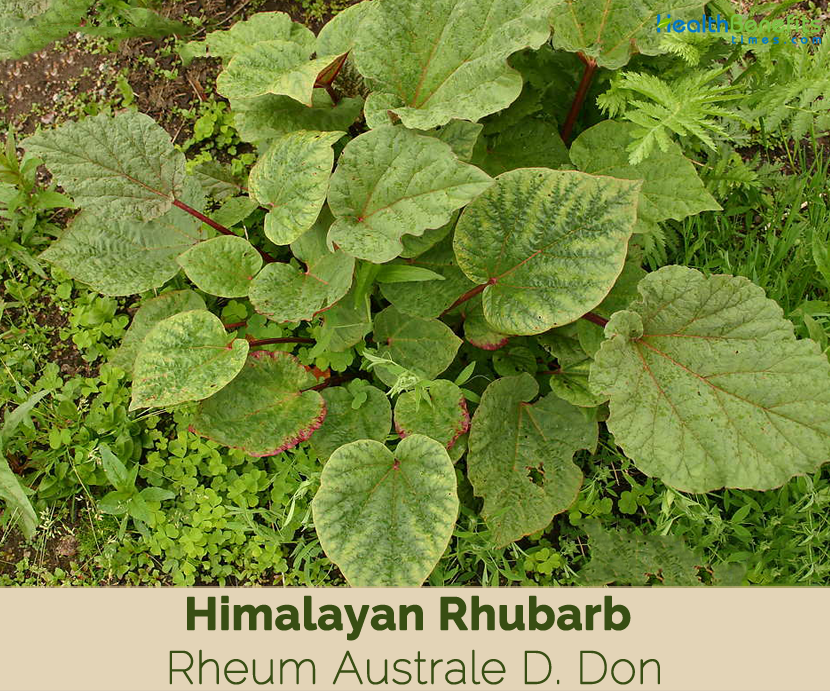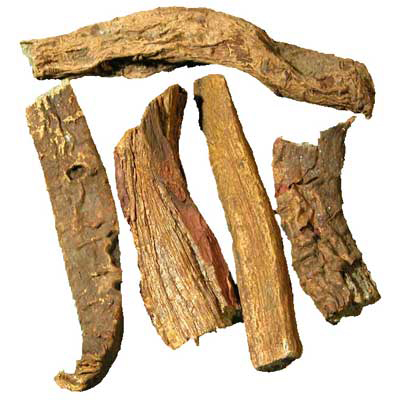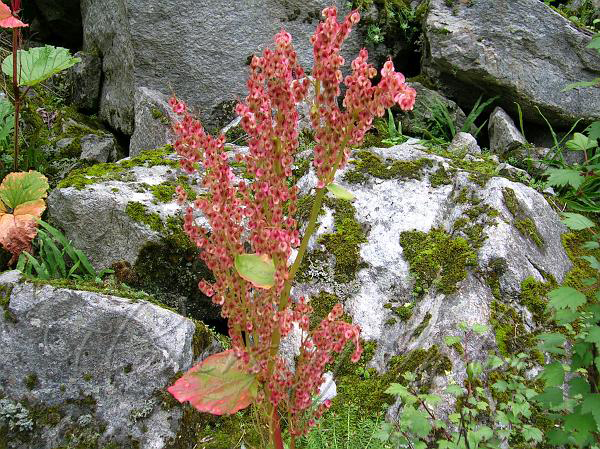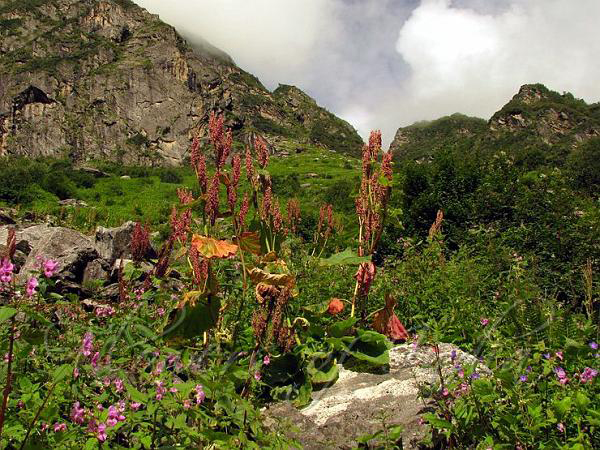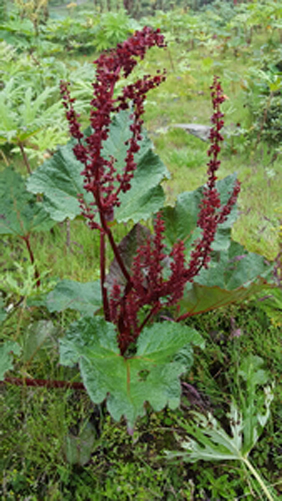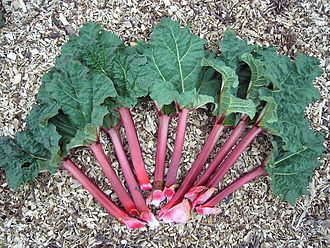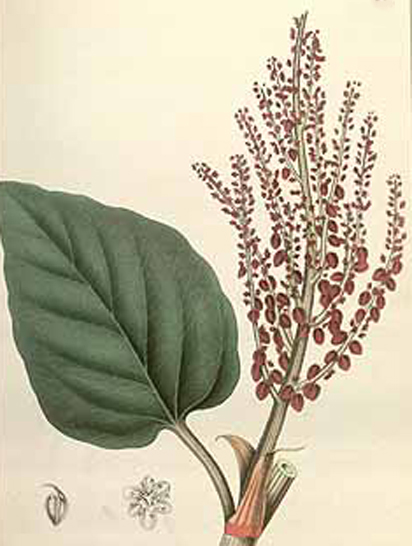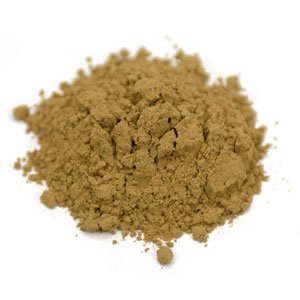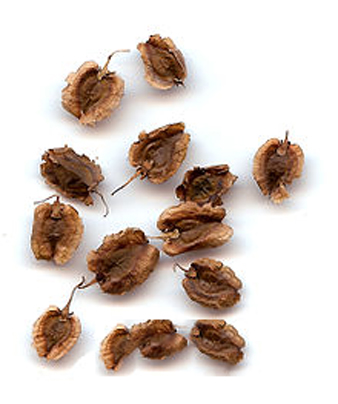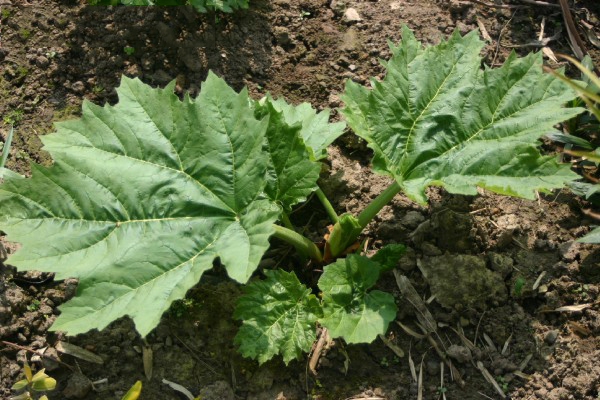| Himalayan Rhubarb Quick Facts |
| Name: |
Himalayan Rhubarb |
| Scientific Name: |
Rheum Australe D. Don |
| Origin |
Higher regions of Himalaya, covering the areas of India (Kashmir and Sikkim), Bhutan, Nepal, Pakistan, Myanmar, and China |
| Colors |
Purple |
| Shapes |
Ovoid-ellipsoid, broadly ellipsoid or ovoid oblong in shape, large (0.5-1.5 cm) long |
| Taste |
Bitter, astringent, sour |
| Health benefits |
Beneficial for chronic constipation, diarrhea, liver & gall bladder complaints, obesity, hemorrhoids, menstrual problems, skin eruptions and urinary problems |
Himalayan Rhubarb scientifically known as Rheum Australe D. Don is a stout rhizomatous plant belonging to the family Polygonaceae and is a medicinal herb used in the Indian Ayurvedic and European medicines. The plant has been cultivated over 5000 years for its medicinal properties. Himalayan rhubarb was formerly known by the synonymous name of Rheum emodi. The plant is native to higher regions of Himalaya, covering the areas of India (Kashmir and Sikkim), Bhutan, Nepal, Pakistan, Myanmar, and China. Few of the popular common names of the plant are Himalayan rhubarb, Indian rhubarb, Red-veined pie plant, Red Vein Rhubarb, Nepal rhubarb and red-veined Himalayan rhubarb. Genus name comes from the Greek name for the roots and rhizomes imported from Iran (or genus name comes from the Greek word rha which is the ancient Greek name for the common rhubarb). Specific epithet comes from the Latin word australis meaning from the south. It has been using for more than two thousand years in the traditional medical systems and is known as the “Lord” or “King of herbs”.
It has been commonly used in traditional medicine for a wide range of ailments related to the circulatory, digestive, endocrine, respiratory and skeletal systems as well as to infectious diseases. The plants consist of Hydroxyanthracene derivatives such as rhein, emodin, chrysophanol and their glycosides. The plant is edible and has effect of balancing the whole digestive system. Rhubarb root is anti-cholesterolemic, antispasmodic, antitumor, diuretic, laxative, purgative, stomachic and tonic.
Unlike its culinary cousin (Rheum x hybridum) which is the rhubarb grown as a vegetable for harvest of its edible leaf stalks, Himalayan rhubarb is basically grown as an ornamental for enjoyment of its huge rounded leaves and feathery plumes of summer flowers, and as a medicinal plant for treating a wide range of human medical problems in the circulatory, digestive, endocrine, respiratory and skeletal systems.
Plant description
Himalayan Rhubarb is a multipurpose, endemic, robust perennial, endangered medicinal herb that grows about 1-3 m tall. The plant is found growing in alpine zone on rocky soil, moraines, and crevices, between boulders and near streams in specific pockets, grassy or rocky slopes and forest margins. The plant prefers a deep, organically rich, fertile, moderately heavy, humus rich, moisture retentive and well-drained soil. The plant has stout stems that are streaked green and brown, glabrous or pubescent at the nodes 1.5-2 m high.
Leaves
Basal leaves have 30-40 long petioles and thick blades. Leaves are thick, orbicular, ovate-elliptic or broadly ovate with 5-7 basal veins, a cordate base, entire margin and sinuolate with an obtuse apex. Upper leaves are smaller.
Flower & fruit
Flowers are pedicellate and dark purple. Perianth are smaller and oblong elliptic. Filaments are subulate. Ovary is rhomboid-obovoid and stigma is oblate and muricate. Flowering normally takes place from June to July. Fertile flowers are followed by fruit that is ovoid-ellipsoid, broadly ellipsoid or ovoid oblong in shape, large (0.5-1.5 cm) long and purple with wings more narrow that thick and notched at both ends. Harvesting of seeds starts from July to September.
Traditional uses and benefits of Himalayan Rhubarb
- Rhubarb has a long and proven history of herbal usage, its main effect being a positive and balancing effect upon the whole digestive system.
- It is one of the most widely used herbs in Chinese medicine.
- Root is anti-cholesterolemic, antiseptic, antispasmodic, antitumor, aperient, astringent, cholagogue, demulcent, diuretic, laxative, purgative, stomachic and tonic.
- Small doses act as an astringent tonic to the digestive system, whilst larger doses act as a mild laxative.
- Root is taken internally in the treatment of chronic constipation, diarrhea, liver and gall bladder complaints, hemorrhoids, menstrual problems and skin eruptions due to an accumulation of toxins.
- Externally, the root is used in the treatment of burns.
- Homeopathic remedy is prepared from the dried root.
- This is used particularly in the treatment of diarrhea in teething children.
- It can be used internally to treat intestinal worms as well as externally in compresses or poultices to treat burns, wounds, carbuncles and boils.
- This herb is planned as a treatment for acute constipation or gastrointestinal problems.
- It is used to counteract Hemorrhoids.
- Rhubarb reduces the high cholesterol level.
- It resolves various kidney diseases.
- It helps to lower the high blood pressure during pregnancy.
- It is useful in reducing the body weight and cures obesity.
- It treats liver diseases and gallbladder diseases.
- It relieves pain from swelling and inflammation.
- It is an aid for menstrual disorders. It also provides relief from pain associated with mensuration
- It is used as a mouthwash for Canker Sores.
- It is an effective herb for urinary problems and helps in easy passing of urine.
- It is a good remedy for poor appetite.
- Rhizomes that are soaked with water are used for herbal bath for babies to remove heat from the body.
Ayurvedic Health benefits of Himalayan Rhubarb
- Indigestion: Soak the root stock of Rhubarb in some cold water for 9-10 hours. Take One tablespoon just before meals.
- Laxative: Soak the root stock in cold water for a day. Take One tablespoon twice a day.
- High Creatinine: Take 2 small stalks of Rhubarb and boil them in water. Strain and drink this tea twice in a day.
- Cancer (Basic): Mix dry, powdered herbs of 6 parts Burdock Root, 4 parts Sheep Sorrel, 1 part Slippery Elm Bark and 1 teaspoon Rhubarb Root. Prepare a decoction. Take one teaspoon at a time. Boil in two cups water till water remains half. Leave on hot plate overnight. Strain through a coarse strainer. Consume cold either early morning or late at night.
- Cancer (Advanced): Add 2 parts Kelp, 1 part Red Clover, 1 part Blessed Thistle and 0.4 parts Watercress. Prepare a decoction. Take one teaspoon at a time. Boil in two cups water till water remains half. Leave on hot plate overnight. Strain through a coarse strainer. Consume cold either early morning or late at night.
- Constipation: Prepare a decoction of Sodium Sulphate and Rhubarb. Use it twice a day.
- Water Retention: Make powder of roasted Euphorbia, Rhubarb root and Sodium Sulphate. Take twice a day. Caution: Excess use may cause toxicity.
- Cough: Ground Areca Nut seed, Ipomoea Nil seed and Rhubarb root in to a powder. Make an infusion. Take it twice a day.
- Dysuria: Prepare a decoction of Stephania Tetrandra root, Rhubarb root and Descurainia Seed. Take it twice a day.
- Jaundice: Make a decoction of Rhubarb root, Water Plantain leaves, Gardenia fruit and Knotgrass leaves. Take it twice a day.
- Constipation: Take equal quantity of Bitter Orange, Magnolia and Rhubarb. Powder them together. Have half teaspoon with lukewarm water once a day.
Culinary uses
- Leaf stem are consumed raw or cooked.
- The crop is occasionally blanched by excluding light from the growing stems, this produces an almost white stem that is free of fiber, crisp and less acid.
- Stems can also be made into a preserve or be dried and stored for later use.
Other facts
- Leaves can be up to 1 meter in diameter, they are used as a lining material and also to cover and protect fruit in baskets.
- Bright yellow dye is obtained from the root.
- This herb may turn urine dark yellow or red, but this is not a cause for alarm.
Precautions
- People with a tendency to rheumatism, arthritis, gout, kidney stones or hyperacidity should take especial caution if including this plant in their diet since it can worsen their condition.
- It should not be taken for a long period of time as the bowels may become dependent upon it in order to function or it may mask a more serious medical problem.
- Leaves of rhubarb plants consist of high amounts of toxic substances known as oxalates. For this reason, the plant’s leaves should never be ingested.
- Rhubarb root should not be used by people with kidney disease, including kidney stones.
- It should also not be taken by children under twelve years of age.
- Women who are pregnant or breastfeeding or people who have been diagnosed with colitis or an obstruction in the intestinal tract should avoid using this herb.
- People who are taking any kind of blood medications, including blood thinners or other laxatives should consult with their medical provider before taking rhubarb root.
- It may cause stomach ache, diarrhea, and nausea.
- Regular use may lead to Muscular Cramp, Bone Pains, and Arrhythmia.
- Avoid in case of Stomach and Spleen deficiency due to Cold.
- Do not use in case of Blood Deficiency.
References:
https://davesgarden.com/guides/pf/go/81473/
https://pfaf.org/user/Plant.aspx?LatinName=Rheum+australe
http://www.missouribotanicalgarden.org/PlantFinder/PlantFinderDetails.aspx?taxonid=285486&isprofile=0&letter=R
https://npgsweb.ars-grin.gov/gringlobal/taxonomydetail.aspx?id=31103
http://www.theplantlist.org/tpl/record/tro-26001861
http://envis.frlht.org/plantdetails/53f32dde5953a5fe23ddc746b3bca276/0cc5c83b964143a0fa128f301bfe14e0
http://www.academia.edu/5591230/Rheum_australe
https://plants.usda.gov/java/ClassificationServlet?source=profile&symbol=RHEUM&display=31
Comments
comments


